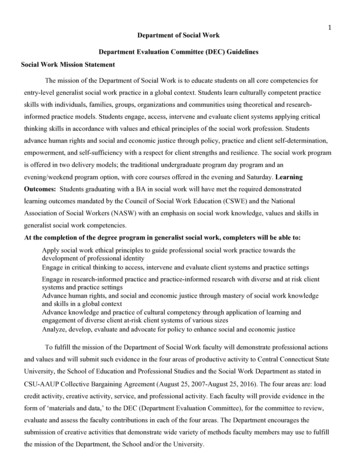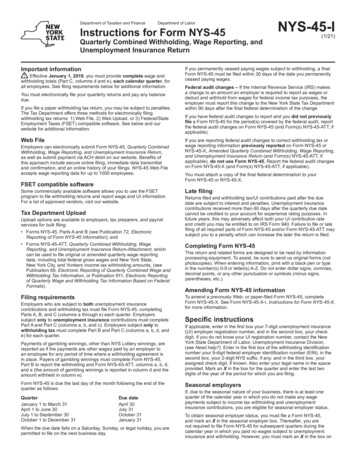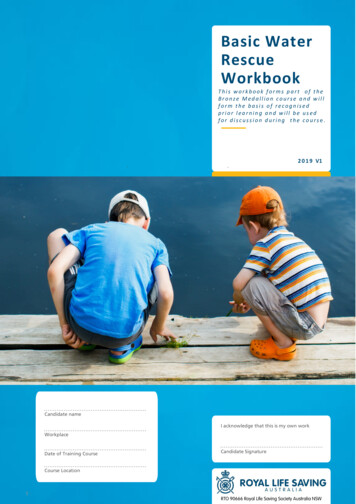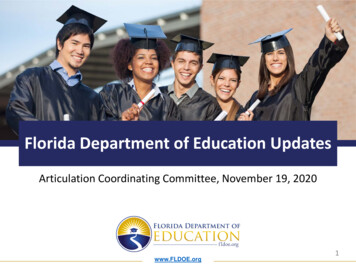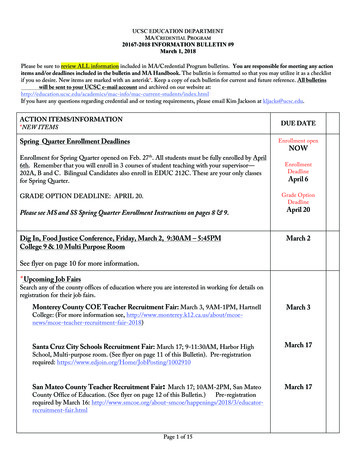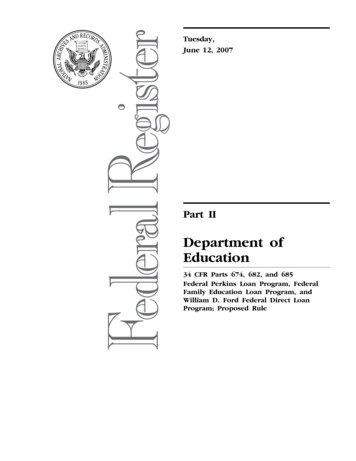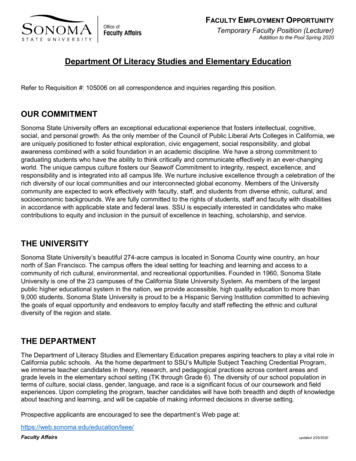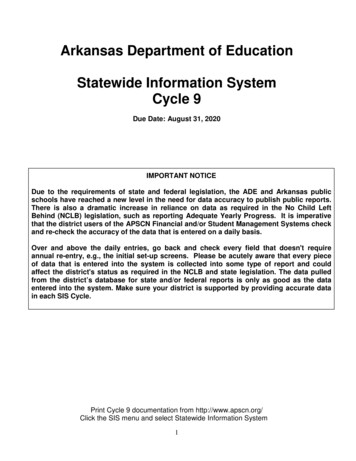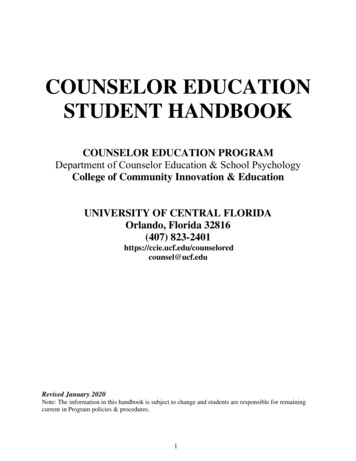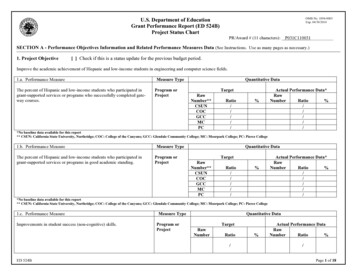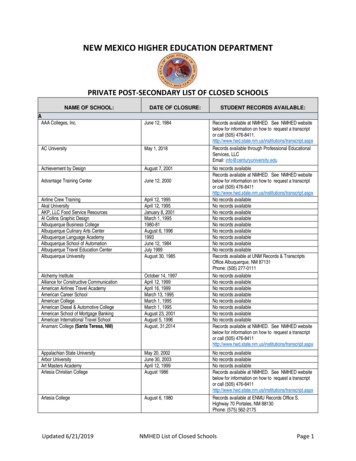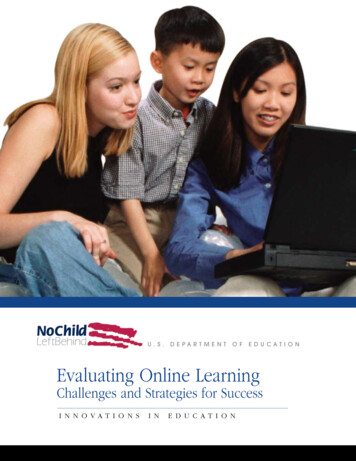
Transcription
U. S .D E PA R T M E N TO FE D U CAT I O NEvaluating Online LearningChallenges and Strategies for SuccessI n n o v a t io n si nE d u c a t io n
Evaluating Online LearningChallenges and Strategies for SuccessI n n o v a t io n si nE d u c a t io nPrepared by WestEdWith Edvance Research, Inc.ForU.S. Depar tment of EducationOffice of Innovation and Improvement2008
This report was produced under U.S. Department of Education Contract No. ED-01-CO-0012, Task OrderD010, with WestEd. Sharon Kinney Horn served as the contracting officer’s representative. The contentof this report does not necessarily reflect the views or policies of the U.S. Department of Education, nordoes the mention of trade names, commercial products or organizations imply endorsements by the U.S.government. This publication also contains URLs for information created and maintained by private organizations. This information is provided for the reader’s convenience. The U.S. Department of Educationis not responsible for controlling or guaranteeing the accuracy, relevance, timeliness, or completeness ofthis outside information. Further, the inclusion of information or URL does not reflect the importance ofthe organization, nor is it intended to endorse any views expressed, or products or services offered.U.S. Department of EducationMargaret SpellingsSecretaryOffice of Innovation and ImprovementDoug MesecarAssistant Deputy SecretaryTechnology in Education ProgramsCheryl GarnetteDirectorJuly 2008This report is in the public domain. Authorization to reproduce it in whole or in part is granted. Whilepermission to reprint this publication is not necessary, the citation should be: U.S. Department ofEducation, Office of Innovation and Improvement, Evaluating Online Learning: Challenges and Strategies for Success, Washington, D.C., 2008.To order copies of this report (order number ED004344P),write to: ED Pubs, Education Publications Center, U.S. Department of Education, P.O. Box 1398, Jessup, MD 20794-1398;or fax your request to: 301-470-1244;or e-mail your request to: edpubs@inet.ed.gov;or call in your request toll-free: 1-877-433-7827 (1-877-4-ED-PUBS). Those who use a telecommunications device for the deaf (TDD) or a teletypewriter (TTY), should call 1-877-576-7734. If 877 service is not yet available in your area, call 1-800-872-5327 (1-800-USA-LEARN; TTY: 1-800-437-0833);or order online at: http://www.edpubs.ed.gov.This report is also available on the Department’s Web site neOn request, this publication is available in alternate formats, such as Braille, large print, or computerdiskette. For more information, please contact the Department’s Alternate Format Center at 202-260-0852or 202-260-0818.
ContentsList of tion1Common Challenges of Evaluating Online Learning (1)The Featured Evaluations (2)What’s in This Guide (3)Part I: Challenges of Evaluating Online Learning7Meeting the Needs of Multiple Stakeholders (7)Building on the Existing Base of Knowledge (12)Evaluating Multifaceted Online Resources (20)Finding Appropriate Comparison Groups (26)Solving Data Collection Problems (33)Interpreting the Impact of Program Maturity (40)Translating Evaluation Findings Into Action (43)Part II: Recommendations for Evaluating Online Learning49General Recommendations (49)Recommendations for Meeting the Needs of Multiple Stakeholders (50)Recommendations for Utilizing and Building on the Existing Base ofKnowledge (50)Recommendations for Evaluating Multifaceted Resources (52)Recommendations for Programs Considering a Comparison Study (52)Recommendations for Gathering Valid Evaluation Data (53)Recommendations for Taking Program Maturity Into Account (54)Recommendations for Translating Evaluation Findings Into Action (54)Featured Online Learning Evaluations55Appendix A: Resources59Distance Learning (59)Evaluation Methods and Tools (60)Resources From Higher Education (61)Appendix B: Research Methodology63Glossary of Common Evaluation Terms65Notes67iii
IllustrationsFIGURES1. Excerpt From Digital Learning Commons’ Meeting 21st Century Learning Challengesin Washington State242. Example of Tabulated Results From an Arizona Virtual Academy Online Parent SurveyAbout the Quality of a Recent Student Workshop38TABLES1. Selected Variables of Profiled Online Learning Evaluations42. Excerpt From Appleton eSchool’s Online Program Perceiver Instrument173. Evaluation Design Characteristics284. Excerpts From AZVA’s Next Steps Plan, In Response to RecommendationsFrom the K12 Quality Assurance Audit47iv
ForewordEducation in this country has evolved dramatically from the days of one teacher in a one-roomschoolhouse. Today, student learning is no longer confined to a physical space. Computers and theInternet have broken through school walls, giving students greater opportunities to personalize theireducation, access distant resources, receive extra help or more-challenging assignments, and engagein learning in new and unique ways.Although online learning is a relatively new enterprise in the K–12 arena, it is expanding rapidly,with increasing numbers of providers offering services and more students choosing to participate. Aswith any education program, online learning initiatives must be held accountable for results. Thus,it is critical for students and their parents—as well as administrators, policymakers, and funders—tohave data informing them about program and student outcomes and, if relevant, about how well aparticular program compares to traditional education models. To this end, rigorous evaluations areessential. They can identify whether programs and online resources are performing as promised, and,equally important, they can point to areas for improvement.The evaluations highlighted in this guide represent a broad spectrum of online options, from programs that provide online courses to Web sites that feature education resources. The evaluationsthemselves range from internal assessments to external, scientific research studies. All demonstratehow program leaders and evaluators have been able to implement strong evaluation practices despitesome challenges inherent to examining learning in an online environment.This guide complements another publication, Connecting Students to Advanced Courses Online, published last year by the U.S. Department of Education. Both are part of the Innovations in Educationseries, which identifies examples of innovative practices from across the country that are helpingstudents achieve.My hope is that this guide will assist evaluators and program leaders who seek to use data to guideprogram improvement aimed at achieving positive outcomes for our nation’s students.Margaret Spellings, SecretaryU.S. Department of Educationv
AcknowledgmentsThis guide was developed under the auspicesof the U.S. Department of Education’s Office ofInnovation and Improvement. Sharon Horn wasproject director.An external advisory group provided feedbackto refine the study scope, define the selectioncriteria, and clarify the text. Members includedRobert Blomeyer, president, Blomeyer & Clemente Consulting Services; Tom Clark, president,TA Consulting; Trina Davis, president, International Society for Technology in Education, andassistant professor and director of eEducation,Texas A&M University; Helene Jennings, vicepresident, Macro International, Inc.; Liz Pape,president and chief executive officer of VirtualHigh School Global Consortium; and Lisa Evans,director, Center for Evaluation Capacity Building, Wexford, Inc.Staff in the Department of Education whoprovided input and reviewed drafts includeSue Betka, Cynthia Cabell, Tom Corwin, KateDevine, David Dunn, Lorenzo Esters, Meredith Farace, Steve Fried, Cheryl Garnette, Virginia Gentles, Robin Gilchrist, Doug Herbert, Nettie Laster, Brian Lekander, Meghan Lerch, Tiffany Taber, Linda Wilson, and Jacquelyn Zimmermann. This guide would not be possible without the support of Tim Magner, director, Office of E ducational Technology.The seven online programs that participated inthe development of this guide and the case studies on which it is based were generous with boththeir time and attention.Alabama Connecting Classrooms, Educators, &Students Statewide Distance LearningAlabama Department of Education50 N. Ripley St.P.O. Box 302101Montgomery, AL 36104http://accessdl.state.al.usAlgebra I OnlineLouisiana Virtual SchoolLouisiana Department of EducationP.O. Box 94064Baton Rouge, LA lgebraAppleton eSchool2121 E. Emmers DriveAppleton, WI 54915http://www.aasd.k12.wi.us/EschoolArizona Virtual Academy4595 S. Palo Verde RoadSuite 517/519Tucson, AZ 85714http://www.azva.orgChicago Public Schools’ Virtual High School125 S. Clark St.Chicago, IL 60603http://clear.cps.k12.il.us/ohsp/distance learning.htmlDigital Learning CommonsCorbet Building4507 University Way NESuite 204Seattle, WA nd Public Television11767 Owings Mills Blvd.Owings Mills, MD 21117http://www.thinkport.orgin partnership with:Johns Hopkins Center for Technology in Education6740 Alexander Bell DriveSuite 302Columbia, MD 21046http://cte.jhu.edu/index.htmvii
IntroductionThis guide is designed as a resource for leaders and evaluators of K–12 online learning programs. Inthis guide the term “online learning” is used to refer to a range of education programs and resourcesin the K–12 arena, including distance learning courses offered by universities, private providers, orteachers at other schools; stand-alone “virtual schools” that provide students with a full array of onlinecourses and services; and educational Web sites that offer teachers, parents, and students a range ofresources.1 The guide features seven evaluations that represent variety in both the type of program orresource being evaluated, and in the type of evaluation. These evaluations were selected because theyoffer useful lessons to others who are planning to evaluate an online learning program or resource.Of course, evaluating online learning is not altogether different from assessing any other type ofeducation program, and, to some degree, evaluators may face the same kind of design andanalysis issues in both instances. Still, onlineprogram evaluators may encounter some unanticipated challenges in the virtual arena owing,for example, to the distance between programsites and students, participants’ unfamiliaritywith the technology being used, and a lack ofrelevant evaluation tools. This guide examines arange of challenges that online program evaluators are likely to meet, some that are uniqueto online settings and others that are more general. It also describes how online environmentscan sometimes offer advantages to evaluatorsby presenting opportunities for streamlined datacollection and analysis, for example.The guide specifically focuses on challengesand response strategies. All of the evaluationsdescribed here illustrate strong assessment practices and robust findings, and they are modelsfor demonstrating how program leaders andevaluators can handle the challenges of evaluating online learning.Common Challenges of EvaluatingOnline LearningOnline learning is a relatively new developmentin K–12 education but is rapidly expandingin both number of programs and participants.According to a report by the North AmericanCouncil for Online Learning (NACOL), “As ofSeptember 2007, 42 states [had] significant supplemental online learning programs (in whichstudents enrolled in physical schools take oneor two courses online), or significant full-timeprograms (in which students take most or allof their courses online), or both.”2 In addition,the Internet houses an ever-expanding numberof Web sites with a broad range of educationresources for students, parents, and teachers.Given this expansion and a dearth of existingresearch on the topic, it is critical to conductrigorous evaluations of online learning in K–12settings to ensure that it does what people hopeit will do: help improve student learning.However, those undertaking such evaluationsmay well encounter a number of technical andmethodological issues that can make this type1
Evaluating Online Learning: Challenges and Strategies for SuccessI n n o vat io n s i n E d u c at io nof research difficult to execute. For example, thescant research literature on K–12 online learningevaluation provides few existing frameworks tohelp evaluators describe and analyze programs,or tools, such as surveys or rubrics, they canuse to collect data or assess program quality.Another common challenge when students arestudying online is the difficulty of examiningwhat is happening in multiple, geographicallydistant learning sites. And multifaceted education resources—such as vast Web sites offeringa wide range of features or virtual schools thatoffer courses from multiple vendors—are alsohard to evaluate, as are programs that utilizetechnologies and instructional models that arenew to users.Furthermore, evaluations of online learning often occur in the context of a politically loaded debate about whether such programs areworth the investment and how much fundingis needed to run a high-quality program; aboutwhether online learning really provides studentswith high-quality learning opportunities; andabout how to compare online and traditionalapproaches. Understandably, funders and policymakers—not to mention students and theirparents—want data that show whether onlinelearning can be as effective as traditional educational approaches and which online models arethe best. These stakeholders may or may notthink about evaluation in technical terms, but allof them are interested in how students performin these new programs. At the same time, manyonline program leaders have multiple goals inmind, such as increased student engagement orincreased student access to high-quality coursesand teachers. Th
Example of Tabulated Results From an Arizona Virtual Academy Online Parent Survey About the Quality of a Recent Student Workshop 38 TABLES 1. Selected Variables of Profiled Online Learning Evaluations 4 2. Excerpt From Appleton eSchool’s Online Program Perceiver Instrument 17 3. Evaluation Design Characteristics 28 4. Excerpts From AZVA’s Next Steps Plan, In Response to
